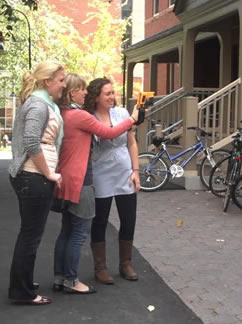|
Smith College Team Develops Way to Measure
Energy Savings
NORTHAMPTON, Mass. -- Smith College engineering students and faculty recently developed a method to measure how much energy can be saved through individual building improvements.
The method is designed for college campuses, which have multiple buildings on a shared heating system and no way to pinpoint building-by-building how much energy is being consumed or, therefore, how much can be saved through renovations.
“When we realized that there was a great need for institutions to be able to quantify their heating loads and consider appropriate and cost-effective building retrofits, this project was born,” says Denise McKahn, assistant professor of engineering, who enlisted Etta Grover-Silva ’10, an engineering major, on the project.
The pair began designing their measurement method in the summer of 2009, in response to a need for specific data to include in the College Sustainability and Climate Action Management Plan (SCAMP), a long-term strategy to reduce the college’s carbon footprint.
They determined a way to accurately estimate the total campus heating load, the energy savings of building retrofits such as new windows, wall and ceiling insulation, and the payback periods associated with the work.
Until recently, a very rough guess as to how much energy would be saved by retrofitting buildings was all that planners had, says McKahn. “We hope that our methods can be used for strategic retrofit planning that specifically target energy savings.”
And, they hope that other colleges and universities will be able to benefit from their method.
Grover-Silva and McKahn recently presented their work to the Association for the Advancement of Sustainability in Higher Education and submitted it to the American Society of Mechanical Engineers (ASME) International Mechanical Engineering Conference and Exposition.
 |
| Smith engineering students (left to right) Courtney Murhpy '11, Katie
MacKenzie '11 and Darcy Dwyer '11 take a thermal image of the front of
Lawrence House. |
Since Grover-Silva’s graduation, McKahn has continued to work on the project with three student research assistants—Darcy Dwyer ’11, Katherine MacKenzie ’11 and Monique Gagne ’13— in order to validate their work through experiments.
To test the model, the students used calculations from air-flow tests that were conducted by local company, Cozy Home Performance. The company measured heat loss in three recently renovated houses – Park, Lawrence and Morris – by de-pressurizing the buildings using high-pressure fans to draw air outward, then blowing air and fog inside to view the paths of air movement and locate leaks.
Once the air-flow tests validate the effectiveness of the new method, the information will be given to facilities management for use in future planning.
The intention: reducing Smith’s campus carbon footprint one building at a time.
-30-
|























